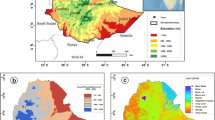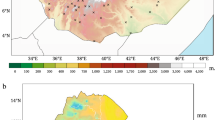Abstract
Environmental studies that include studies related to climate change, change in biodiversity, and hydrology consider land surface temperature (LST) and near-surface air temperature as significant variables to contribute. In this context, we investigated the time series assessment of the relationship between LST and elevation over the two decades (1995–2017) using remotely sensed (Landsat 5, Landsat 7, Landsat 8, MODIS) and ground weather stations’ datasets. The study area that is Gilgit-Baltistan, northern province of Pakistan in Hindukush and Himalaya Region (HKH), was selected for quantitative analysis in this study as it has high significance in terms of climate change due to presence of very high and large number of mountains and difficult terrain heavily covered with snow and glaciers. To assess the LST, a linear regression model was developed to quantify the significance of key factors affecting it. Our research results show that there exists a strong negative linear relationship (with correlation coefficient of 0.61 on average) for all datasets (remotely sensed and in situ) between LST and elevation and it is consistent over the study period (1995–2017) for both seasons of winter and summer. Further, there is a difference of change in LST for different seasons (average winter and summer difference is 3.0 °C) and for different datasets (Landsat, MODIS, and weather stations’ dataset). There is a greater change in LST for change of elevation in 1000 m vertically as compared to change horizontally. Our results indicate that the change trend in LST from 1995 to 2007 is downward with minor variation, however, this trend changes into upward trend from 2007 to 2017. The comparison of results of remotely sensed and weather stations’ dataset shows that there is a consistency of change in temperature and LST due to change in elevation. However, there is a less difference in summers (0.76 °C) and large difference in winters, i.e., 3.94 °C.









Similar content being viewed by others
References
Acharya B, Cao C, Xu M, Khanal L, Naeem S, Pandit S (2018) Temporal variations and associated remotely sensed environmental variables of dengue fever in Chitwan District, Nepal. ISPRS Int J Geo Inf 7(7):275
Aguilar-Lome J, Espinoza-Villar R, Espinoza JC, Rojas-Acuña J, Willems BL, Leyva-Molina WM (2019) Elevation-dependent warming of land surface temperatures in the Andes assessed using MODIS LST time series (2000–2017). Int J Appl Earth Obs Geoinf 77:119–128
Anderson MC, Norman JM, Kustas WP, Houborg R, Starks PJ, Agam N (2008) A thermal-based remote sensing technique for routine mapping of land-surface carbon, water and energy fluxes from field to regional scales. Remote Sens Environ 112(12):4227–4241
Avdan U, Jovanovsmmka G (2016, 2016) Algorithm for automated mapping of land surface temperature using LANDSAT 8 satellite data. J Sens
Baig S, Khan AA, Khan AA, Bano S (2019) Rural tourism, income and rapid urbanization: exploring the nexus using a multidisciplinary approach for Hunza, Pakistan. Int J Econ Environ Geol 10(4):1–6
Barnett TP, Adam JC, Lettenmaier DP (2005) Potential impacts of a warming climate on water availability in snow-dominated regions. Nature 438(7066):303
Benrazavi RS, Dola KB, Ujang N, Benrazavi NS (2016) Effect of pavement materials on surface temperatures in tropical environment. Sustain Cities Soc 22:94–103
Bibi L, Khan AA, Khan G, Ali K, Qureshi J, Jan IU (2019) Snow cover trend analysis using modis snow products: a case of Shayok River Basin in Northern Pakistan. Journal of Himalayan Earth Science 52(2).
Bokaie M, Zarkesh MK, Arasteh PD, Hosseini A (2016) Assessment of urban heat island based on the relationship between land surface temperature and land use/land cover in Tehran. Sustain Cities Soc 23:94–104
Brunsell NA, Gillies RR (2003) Length scale analysis of surface energy fluxes derived from remote sensing. J Hydrometeorol 4(6):1212–1219
Chen YC, Chiu HW, Su YF, Wu YC, Cheng KS (2017) Does urbanization increase diurnal land surface temperature variation? Evidence and implications. Landsc Urban Plan 157:247–258
Deng Y, Wang S, Bai X, Tian Y, Wu L, Xiao J, Qian Q (2018) Relationship among land surface temperature and LUCC, NDVI in typical karst area. Sci Rep 8(1):641
Diba I, Camara M, Sarr A, Diedhiou A (2018) Potential impacts of land cover change on the interannual variability of rainfall and surface temperature over West Africa. Atmosphere 9(10):376
Emmert-Streib F, Dehmer M (2019) Evaluation of regression models: model assessment, model selection and generalization error. Machine Learning and Knowledge Extraction 1(1):521–551. https://doi.org/10.3390/make1010032
Fu P, Weng Q (2016) A time series analysis of urbanization induced land use and land cover change and its impact on land surface temperature with Landsat imagery. Remote Sens Environ 175:205–214
Hewitt K (2005) The Karakoram anomaly? Glacier expansion and the ‘elevation effect’ Karakoram Himalaya. Mt Res Dev 25(4):332–340
Hewitt K (2011) Glacier change, concentration, and elevation effects in the Karakoram Himalaya, Upper Indus Basin. Mt Res Dev 31(3):188–200
Ji F, Wu Z, Huang J, Chassignet EP (2014) Evolution of land surface air temperature trend. Nat Clim Chang 4(6):462–466
Karnieli A, Agam N, Pinker RT, Anderson M, Imhoff ML, Gutman GG, Goldberg A (2010) Use of NDVI and land surface temperature for drought assessment: merits and limitations. J Clim 23(3):618–633
Khan AA, ul Hassan SN, Baig S, Khan MZ, Muhammad A (2019) The response of land surface temperature to the changing land-use land-cover in a mountainous landscape under the influence of urbanization: Gilgit City as a case study in the Hindu Kush Himalayan Region of Pakistan. Int J Econ Environ Geol 10(3):40–49
Khandelwal S, Goyal R, Kaul N, Mathew A (2018) Assessment of land surface temperature variation due to change in elevation of area surrounding Jaipur, India. Egypt J Remote Sens Space Sci 21(1):87–94
Kuang W, Liu Y, Dou Y, Chi W, Chen G, Gao C, Zhang R (2015) What are hot and what are not in an urban landscape: quantifying and explaining the land surface temperature pattern in Beijing, China. Landsc Ecol 30(2):357–373
Kumar P, Kotlarski S, Moseley C, Sieck K, Frey H, Stoffel M, Jacob D (2015) Response of Karakoram-Himalayan glaciers to climate variability and climatic change: a regional climate model assessment. Geophys Res Lett 42(6):1818–1825
Kustas W, Anderson M (2009) Advances in thermal infrared remote sensing for land surface modeling. Agricultural and Forest Meteorology, 149(12), 2071-2081.
Li ZL, Bo HT, Hua W, Huazhong RG, Yan ZW, Isabel F, Trigo JAS (2013) Satellite-derived land surface temperature: current status and perspectives. Remote Sens Environ 131(April 2013):14–37. https://doi.org/10.1016/j.rse.2012.12.008
Liu J, Rasul G (2007) Climate change, the Himalayan mountains, and ICIMOD. Sustain Mountain Dev 53:11–14
Luyssaert S, Jammet M, Stoy PC, Estel S, Pongratz J, Ceschia E et al (2014) Land management and land-cover change have impacts of similar magnitude on surface temperature. Nat Clim Chang 4(5):389–393
Mathew A, Khandelwal S, Kaul N (2016) Spatial and temporal variations of urban heat island effect and the effect of percentage impervious surface area and elevation on land surface temperature: study of Chandigarh city, India. Sustain Cities Soc 26:264–277
Minora U, Bocchiola D, D’Agata C, Maragno D, Mayer C, Lambrecht A, Diolaiuti GA (2016) Glacier area stability in the Central Karakoram National Park (Pakistan) in 2001–2010: the “Karakoram Anomaly” in the spotlight. Prog Phys Geogr 40(5):629–660
Mishra, A., Appadurai, A. N., Choudhury, D., Regmi, B. R., Kelkar, U., Alam, M., ... & Fu, C. (2019). Adaptation to climate change in the Hindu Kush Himalaya: stronger action urgently needed. In The Hindu Kush Himalaya assessment (pp. 457-490). Springer, Cham.
Mohamed AA, Odindi J, Mutanga O (2017a) Land surface temperature and emissivity estimation for Urban Heat Island assessment using medium-and low-resolution space-borne sensors: a review. Geocarto Int 32(4):455–470
Mohamed AA, Odindi J, Mutanga O (2017b) Land surface temperature and emissivity estimation for Urban Heat Island assessment using medium-and low-resolution space-borne sensors: a review. Geocarto Int 32(4):455–470
Pal S, Ziaul S (2017) Detection of land use and land cover change and land surface temperature in English Bazar urban centre. Egypt J Remote Sens Space Sci 20(1):125–145
Pepin N, Bradley RS, Diaz HF, Baraër M, Caceres EB, Forsythe N et al (2015) Elevation-dependent warming in mountain regions of the world. Nat Clim Chang 5(5):424
Pepin N, Deng H, Zhang H, Zhang F, Kang S, Yao T (2019) An examination of temperature trends at high elevations across the Tibetan Plateau: the use of MODIS LST to understand patterns of elevation-dependent warming. Journal of Geophysical Research: Atmospheres
Phan T, Kappas M, Tran T (2018) Land surface temperature variation due to changes in elevation in Northwest Vietnam. Climate 6(2):28
Rohde R, Muller RA, Jacobsen R, Muller E, Perlmutter S, Rosenfeld A et al (2013) A new estimate of the average earth surface land temperature spanning 1753 to 2011. Geoinfor Geostat: An Overview 1:1 of, 7, 2
Sun Q, Tan J, Xu Y (2010) An ERDAS image processing method for retrieving LST and describing urban heat evolution: a case study in the Pearl River Delta Region in South China. Environ Earth Sci 59(5):1047–1055
Tran DX, Pla F, Latorre-Carmona P, Myint SW, Caetano M, Kieu HV (2017) Characterizing the relationship between land use land cover change and land surface temperature. ISPRS J Photogramm Remote Sens 124:119–132
Wark DQ, Yamamoto G, Lienesch JH (1962) Methods of estimating infrared flux and surface temperature from meteorological satellites. J Atmos Sci 19(5):369–384
Weng Q, Lu D, Schubring J (2004) Estimation of land surface temperature–vegetation abundance relationship for urban heat island studies. Remote Sens Environ 89(4):467–483
You QL, Ren GY, Zhang YQ, Ren YY, Sun XB, Zhan YJ et al (2017) An overview of studies of observed climate change in the Hindu Kush Himalayan (HKH) region. Adv Clim Chang Res 8(3):141–147
Zhang F, Tiyip T, Kung H, Johnson VC, Maimaitiyiming M, Zhou M, Wang J (2016) Dynamics of land surface temperature (LST) in response to land use and land cover (LULC) changes in the Weigan and Kuqa river oasis, Xinjiang, China. Arab J Geosci 9(7):499
Zhang X, Estoque RC, Murayama Y (2017) An urban heat island study in Nanchang City, China based on land surface temperature and social-ecological variables. Sustain Cities Soc 32:557–568
Zhengming W, Dozier J (1989) Land-surface temperature measurement from space: physical principles and inverse modeling. IEEE Trans Geosci Remote Sens 27(3):268–278
Zhou W, Huang G, Cadenasso ML (2011) Does spatial configuration matter? Understanding the effects of land cover pattern on land surface temperature in urban landscapes. Landsc Urban Plan 102(1):54–63
Author information
Authors and Affiliations
Corresponding author
Additional information
Responsible Editor: Zhihua Zhang
Rights and permissions
About this article
Cite this article
Khan, A.A., Hussain, D., Ali, K. et al. Time series assessment of the relationship between land surface temperature due to change in elevation: a case study from Hindukush-Himalayan Region (HKH). Arab J Geosci 13, 515 (2020). https://doi.org/10.1007/s12517-020-05530-4
Received:
Accepted:
Published:
DOI: https://doi.org/10.1007/s12517-020-05530-4




